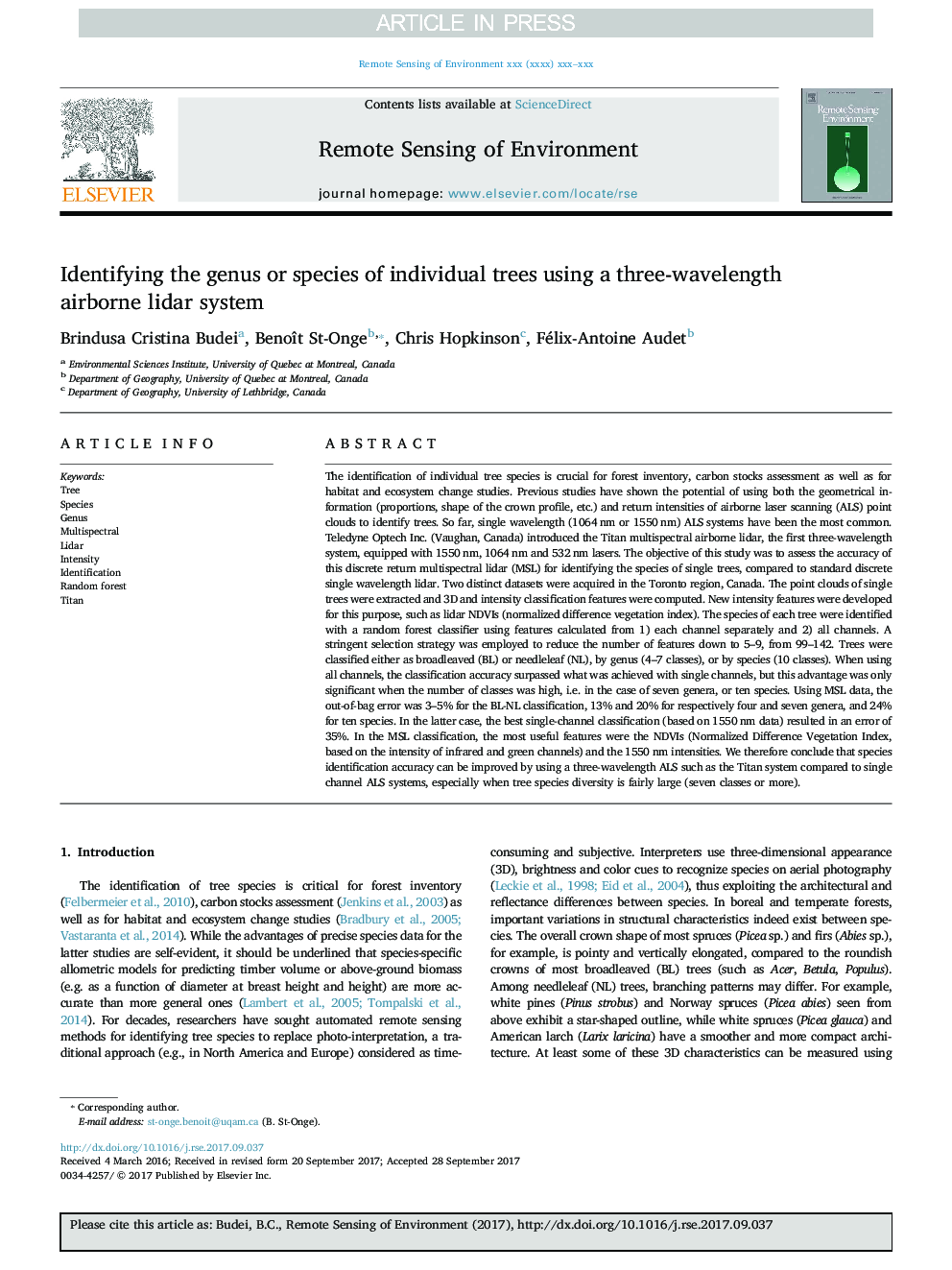| کد مقاله | کد نشریه | سال انتشار | مقاله انگلیسی | نسخه تمام متن |
|---|---|---|---|---|
| 8866884 | 1621196 | 2018 | 16 صفحه PDF | دانلود رایگان |
عنوان انگلیسی مقاله ISI
Identifying the genus or species of individual trees using a three-wavelength airborne lidar system
ترجمه فارسی عنوان
شناسایی جنس یا گونه های درختان فردی با استفاده از سیستم لیادار هوا در هوا سه طول موج
دانلود مقاله + سفارش ترجمه
دانلود مقاله ISI انگلیسی
رایگان برای ایرانیان
کلمات کلیدی
درخت، گونه ها، جنس، چندرسانه ای، لیادور، شدت، شناسایی، جنگل تصادفی تیتان،
موضوعات مرتبط
مهندسی و علوم پایه
علوم زمین و سیارات
کامپیوتر در علوم زمین
چکیده انگلیسی
The identification of individual tree species is crucial for forest inventory, carbon stocks assessment as well as for habitat and ecosystem change studies. Previous studies have shown the potential of using both the geometrical information (proportions, shape of the crown profile, etc.) and return intensities of airborne laser scanning (ALS) point clouds to identify trees. So far, single wavelength (1064Â nm or 1550Â nm) ALS systems have been the most common. Teledyne Optech Inc. (Vaughan, Canada) introduced the Titan multispectral airborne lidar, the first three-wavelength system, equipped with 1550Â nm, 1064Â nm and 532Â nm lasers. The objective of this study was to assess the accuracy of this discrete return multispectral lidar (MSL) for identifying the species of single trees, compared to standard discrete single wavelength lidar. Two distinct datasets were acquired in the Toronto region, Canada. The point clouds of single trees were extracted and 3D and intensity classification features were computed. New intensity features were developed for this purpose, such as lidar NDVIs (normalized difference vegetation index). The species of each tree were identified with a random forest classifier using features calculated from 1) each channel separately and 2) all channels. A stringent selection strategy was employed to reduce the number of features down to 5-9, from 99-142. Trees were classified either as broadleaved (BL) or needleleaf (NL), by genus (4-7 classes), or by species (10 classes). When using all channels, the classification accuracy surpassed what was achieved with single channels, but this advantage was only significant when the number of classes was high, i.e. in the case of seven genera, or ten species. Using MSL data, the out-of-bag error was 3-5% for the BL-NL classification, 13% and 20% for respectively four and seven genera, and 24% for ten species. In the latter case, the best single-channel classification (based on 1550Â nm data) resulted in an error of 35%. In the MSL classification, the most useful features were the NDVIs (Normalized Difference Vegetation Index, based on the intensity of infrared and green channels) and the 1550Â nm intensities. We therefore conclude that species identification accuracy can be improved by using a three-wavelength ALS such as the Titan system compared to single channel ALS systems, especially when tree species diversity is fairly large (seven classes or more).
ناشر
Database: Elsevier - ScienceDirect (ساینس دایرکت)
Journal: Remote Sensing of Environment - Volume 204, January 2018, Pages 632-647
Journal: Remote Sensing of Environment - Volume 204, January 2018, Pages 632-647
نویسندگان
Brindusa Cristina Budei, Benoît St-Onge, Chris Hopkinson, Félix-Antoine Audet,
